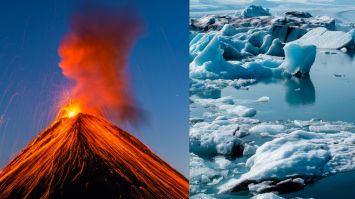Land of Fire and Ice: Iceland is famously known as the Land of Fire and Ice because it is one of the only places in the world where massive glaciers and powerful volcanoes exist side by side. The country’s landscape shifts between icy blue glacier fields, snow-coated mountains, and steaming geothermal areas with erupting volcanoes and bubbling lava. This incredible natural contrast has shaped Iceland’s culture, energy system, tourism industry, and global identity. The title highlights Iceland’s extreme natural beauty and its rare balance of destruction and renewal created by nature itself.
Why Is Iceland Called the Land of Fire and Ice?
Iceland lies on the Mid-Atlantic Ridge, causing volcanic activity, while its northern position and cold ocean currents allow glaciers to thrive. The combination creates extreme seasonal and geological contrasts.

Reasons Why Iceland Is Called the Land of Fire and Ice
Land of Vast Glaciers and Frozen Wilderness
Iceland is blanketed by enormous ice sheets that make up some of the largest glaciers in Europe. These untouched ice fields form dramatic ice caves, glacial lagoons, and frozen valleys that attract explorers from around the world. The glaciers constantly shape the landscape, carving fjords, feeding rivers, and creating glacier-blue lakes that change with the seasons. Every winter, Iceland transforms into an Arctic wonderland, offering majestic frozen scenery influenced by its subpolar location.
Home to Active Volcanoes and Fiery Lava Landscapes
Iceland sits directly on the Mid-Atlantic Ridge, where two tectonic plates meet, causing frequent volcanic activity. The country has more than 100 volcanoes, and eruptions have shaped its geography for thousands of years. Black lava fields, basalt columns, and steaming vents serve as reminders of Iceland’s powerful geothermal forces. Volcanoes like Eyjafjallajökull and Katla continue to influence landforms, culture, flight routes, and even soil fertility, making volcanic fire an essential aspect of Iceland’s natural identity.
Geothermal Energy and Natural Hot Springs
Iceland harnesses underground volcanic heat to produce clean, renewable energy. Geothermal plants power homes, heat water, and support eco-friendly industries, making Iceland one of the world’s most sustainable countries. Natural geysers shoot boiling water into the air, hot springs warm snowy landscapes, and geothermal pools like the Blue Lagoon have become major global attractions. This geothermal power not only supports modern life but also symbolizes Iceland’s harmony with its volcanic environment.
Spectacular Waterfalls, Ice Lagoons, and Surreal Landscapes
Melting glaciers feed some of the most breathtaking waterfalls on Earth, including Gullfoss, Skógafoss, and Dettifoss, known for its thundering power and dramatic gorge. Glacial lakes like Jökulsárlón feature floating icebergs in crystal-clear waters, creating cinematic scenery that reflects the country’s icy magic. Iceland’s unique terrain also includes black sand beaches, ice caves that glow blue, and green volcanic valleys, offering a rare blend of contrasting elements in one destination.
Arctic Wildlife and Northern Lights Wonder
Iceland’s northern location gives it long, snowy winters and short, bright summers. The country becomes a winter paradise where the Northern Lights paint the sky with electric colours, offering one of the world’s best aurora-viewing experiences. Iceland is also home to Arctic wildlife such as puffins, seals, whales, and the Arctic fox. The blend of frozen wilderness, star-lit skies, and wildlife-rich coasts enhances Iceland’s mystical and adventurous appeal.

Interesting Facts About Iceland
1. Home to Europe’s Largest Glacier
Vatnajökull covers much of Iceland and contains valleys, lakes, and even volcanoes beneath its ice. It changes shape constantly due to melting and pressure shifts, offering new natural formations each year.
2. Land of Hundreds of Geothermal Hot Springs
Iceland has countless natural hot springs, both famous and hidden. Some pools are part of luxury spas, while others lie untouched in mountain valleys, giving visitors a therapeutic and authentic geothermal experience.
3. One of the Most Active Volcanic Zones in the World
Volcanoes shape Iceland’s past, present, and future. The 2010 Eyjafjallajökull eruption disrupted global air traffic, showing the world how powerful Iceland’s volcanoes are even today.
4. Almost 100% Renewable Energy Nation
Iceland relies on geothermal and hydropower instead of fossil fuels, making it one of the cleanest and greenest economies globally. Its renewable model is studied by engineers worldwide.
Comments
All Comments (0)
Join the conversation